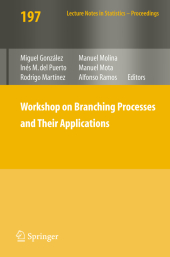 Neuerscheinungen 2010Stand: 2020-01-07 |
Schnellsuche
ISBN/Stichwort/Autor
|
Herderstraße 10
10625 Berlin
Tel.: 030 315 714 16
Fax 030 315 714 14
info@buchspektrum.de |

Miguel González Velasco, Rodrigo Martínez, Manuel Molina, Manuel Mota, Inés M. del Puerto, Alfonso Ramos
(Beteiligte)
Workshop on Branching Processes and Their Applications
Herausgeber: Martínez, Rodrigo, del Puerto, Inés M., Molina, Manuel, González Velasco, Miguel, Mota, Manuel
2010. xx, 296 S. 15 SW-Abb. 235 mm
Verlag/Jahr: SPRINGER, BERLIN 2010
ISBN: 3-642-11154-8 (3642111548)
Neue ISBN: 978-3-642-11154-9 (9783642111549)
Preis und Lieferzeit: Bitte klicken
One of the charms of mathematics is the contrast between its generality and its applicability to concrete, even everyday, problems. Branching processes are typical in this. Their niche of mathematics is the abstract pattern of reproduction, sets of individuals changing size and composition through their members reproducing; in other words, what Plato might have called the pure idea behind demography, population biology, cell kinetics, molecular replication, or nuclear ?ssion, had he known these scienti?c ?elds. Even in the performance of algorithms for sorting and classi?cation there is an inkling of the same pattern. In special cases, general properties of the abstract ideal then interact with the physical or biological or whatever properties at hand. But the population, or bran- ing, pattern is strong; it tends to dominate, and here lies the reason for the extreme usefulness of branching processes in diverse applications. Branching is a clean and beautiful mathematical pattern, with an intellectually challenging intrinsic structure, and it pervades the phenomena it underlies.


